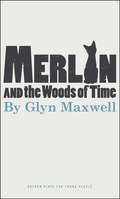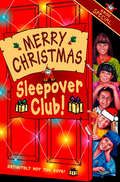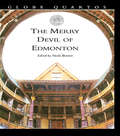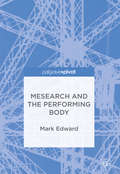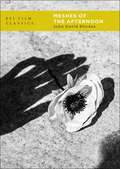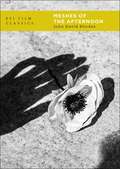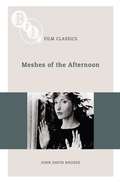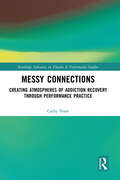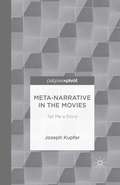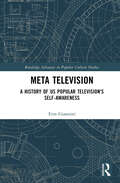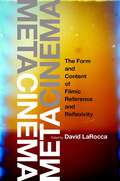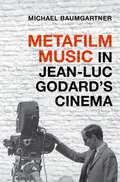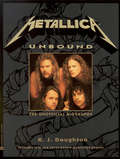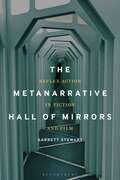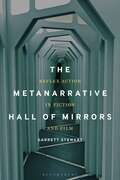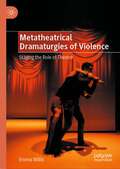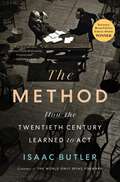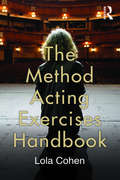- Table View
- List View
Merlin and the Woods of Time (Oberon Modern Plays)
by Glyn MaxwellIt’s a perfect day in Camelot. The Table is Round and the Grail is Holy. Knights joust and Ladies show favour. Blood is spilt, love declared, and medieval pundits talk us through the action. What could possibly go wrong? But then a humble water-carrier falls head-over-heels for an arrogant beauty and in his passion stumbles on the Secret of Controlling Time. Now the survival of the world is in his hands, and it will take more than the wisdom of Merlin to save Old England from catastrophe. Chivalry, showbiz and strange-coloured cocktails meet with Very Weird Results in Merlin and the Woods of Time...
Merry Christmas, Sleepover Club: Christmas Special (The Sleepover Club #36)
by Sue MongredienJoin the Sleepover Club: Frankie, Kenny, Felicity, Rosie and Lyndsey, five girls who want to have fun – but who always end up in mischief!
The Merry Devil of Edmonton (Globe Quartos)
by AnonymousThe Merry Devil of Edmonton lay unperformed from the early seventeenth century until the 1980s. Dating from around 1604, it was first published in 1608 and was performed at the Globe Theatre by the King's Men. With its scenes of magic, deer poaching, and abduction from a nunnery, The Merry Devil of Edmonton combines romance and comedy in a highly entertaining way, and was a favorite production on the seventeenth century stage.
The Merry Devil of Edmonton (Globe Quartos)
by AnonymousThe Merry Devil of Edmonton lay unperformed from the early seventeenth century until the 1980s. Dating from around 1604, it was first published in 1608 and was performed at the Globe Theatre by the King's Men. With its scenes of magic, deer poaching, and abduction from a nunnery, The Merry Devil of Edmonton combines romance and comedy in a highly entertaining way, and was a favorite production on the seventeenth century stage.
Merry Quizmas Everyone!: Christmas quizzes & games to go from the turkey to the King’s speech – have an hilarious holiday spectacular!
by Chris T MassyIt's the most hilarious time of the year...Packed full of festive pop-culture quizzes, Christmas trivia to fascinate and holly jolly games to play - as well as colouring and dot-to-dot pages to distract, and cracking cracker jokes to make you chuckle (and groan).The perfect Christmas companion for work Christmas parties, entertaining friends and family, entertaining kids (including kids), when you're too full to move, there's nothing on the TV, it's too wet for a walk and the pub isn't open yet.A book everyone will love, actually...
Mesearch and the Performing Body (PDF)
by Mark EdwardThis book is an anthology of Mark Edward’s creative practice-led projects. It transmits and communicates his research through varied artistic means, primarily contemporary dance, immersive art installation, drag performance, and photography. Through the innovative practice of 'mesearch', in which the author is both theoriser and theorised, this study delivers a personal, creative narration, combining reflections and emotions in relation to self and performance. Instead of being an attempt to undervalue or challenge the accepted notions of style within academic research, it promotes a freedom of expression which allows greater fluidity between the researcher, the performer, and the writer.
Meshes of the Afternoon (BFI Film Classics)
by John David RhodesMeshes of the Afternoon (1943), filmed by Maya Deren and her then husband Alexader Hammid in their bungalow above Sunset Boulevard for a mere $274.90, is the most important film in the history of American avant-garde cinema. The artistic collaboration between Deren and Hammid finds its distorted reflection in the vision of the film's tormented female protagonist. Its focus - through a series of intricate and interlocking dream sequences - on female experience and the domestic sphere links Meshes to the Hollywood melodramas of the period, while its unsettling atmosphere of dread, death and doubles makes it a counter-cinematic cousin to film noir. The film has influenced not only the subsequent history of experimental film, but also on the work of Hollywood auteurs. It is a touchstone of women's film-making, of modern cinema and of modern art. John David Rhodes traces the film's history back into the lives of Maya Deren and Alexander Hammid, but in particular that of Deren. He reads the film as a culmination of Deren's abiding interest in modernism and her intense engagement in socialist politics. Rhodes argues that while the film remains a powerful point of reference for feminist film-makers and experimentalists, it is also an example of political art in the broadest terms.In his foreword to this new edition, Rhodes reflects upon the film's continuing importance for and influence upon feminist and avant-garde filmmaking.
Meshes of the Afternoon (BFI Film Classics)
by John David RhodesMeshes of the Afternoon (1943), filmed by Maya Deren and her then husband Alexader Hammid in their bungalow above Sunset Boulevard for a mere $274.90, is the most important film in the history of American avant-garde cinema. The artistic collaboration between Deren and Hammid finds its distorted reflection in the vision of the film's tormented female protagonist. Its focus - through a series of intricate and interlocking dream sequences - on female experience and the domestic sphere links Meshes to the Hollywood melodramas of the period, while its unsettling atmosphere of dread, death and doubles makes it a counter-cinematic cousin to film noir. The film has influenced not only the subsequent history of experimental film, but also on the work of Hollywood auteurs. It is a touchstone of women's film-making, of modern cinema and of modern art. John David Rhodes traces the film's history back into the lives of Maya Deren and Alexander Hammid, but in particular that of Deren. He reads the film as a culmination of Deren's abiding interest in modernism and her intense engagement in socialist politics. Rhodes argues that while the film remains a powerful point of reference for feminist film-makers and experimentalists, it is also an example of political art in the broadest terms.In his foreword to this new edition, Rhodes reflects upon the film's continuing importance for and influence upon feminist and avant-garde filmmaking.
Meshes of the Afternoon (BFI Film Classics)
by John David Rhodes?Meshes of the Afternoon (1943) is the most important film in the history of American avant-garde cinema and one of the most significant and influential films in the whole of film history. It was made by Maya Deren and her then husband Alexander Hammid in their bungalow above Sunset Boulevard in Los Angeles for a mere $274.90. The artistic collaboration between Deren and Hammid – which was by all accounts harmonious – finds its distorted and unhappy reflection in the vision of the tormented female protagonist in Meshes of the Afternoon. The film's focus – through a series of intricate and interlocking dream sequences – on female experience and the domestic sphere link it to the Hollywood melodramas of the period, while its unsettling atmosphere of dread, death and doubles makes it a counter-cinematic cousin to film noir. The film has made its influence felt not only on the entire subsequent history of experimental film and video production, but also on the work of Hollywood auteurs. It is a touchstone of women's film-making, of modernist cinema and of modern art. John David Rhodes traces the film's history back into the lives of Maya Deren and Alexander Hammid, but in particular that of Deren. He places special significance on the film as a culmination of Deren's abiding interest in modernism and her intense engagement in socialist politics. Rhodes argues that while the film remains a powerful point of reference for the feminist film-makers and experimentalists who have claimed it as their birthright, it also offers itself as an example of political art in the broadest terms. In Rhodes's original study, Meshes of the Afternoon emerges as a film that is not only artistically ingenious, but also rich in historical significance and political potential.
Messy Connections: Creating Atmospheres of Addiction Recovery Through Performance Practice (ISSN)
by Cathy SloanThis book examines performance practices that involve people in recovery from addiction, theorising such practices as recovery-engaged.Focusing on examples of practice from a growing movement of UK-based recovery arts practitioners and performers, it highlights a unique approach to performance that infuses an understanding of lived experiences of addiction and recovery with creative practice. It offers a philosophy of being in recovery that understands lived experience, and performance practice, as a dynamic system of interrelations with the human and nonhuman elements that make up the societal settings in which recovery communities struggle to exist. It thereby frames the process of recovery, and recovery-engaged performance, as an affective ecology – a system of messy connections. Building upon ideas from posthumanist research on addiction, cultural theory on identity and new materialist interpretations of performance practice, it considers how such contemporary theory might offer additional ways of thinking and doing arts practice with people affected by addiction. The discussion highlights the distinct aesthetics, ethics and politics of this area of performance practice.This study will be of great interest to students and scholars in Applied Theatre and Critical Arts and Mental Health studies.
Messy Connections: Creating Atmospheres of Addiction Recovery Through Performance Practice (ISSN)
by Cathy SloanThis book examines performance practices that involve people in recovery from addiction, theorising such practices as recovery-engaged.Focusing on examples of practice from a growing movement of UK-based recovery arts practitioners and performers, it highlights a unique approach to performance that infuses an understanding of lived experiences of addiction and recovery with creative practice. It offers a philosophy of being in recovery that understands lived experience, and performance practice, as a dynamic system of interrelations with the human and nonhuman elements that make up the societal settings in which recovery communities struggle to exist. It thereby frames the process of recovery, and recovery-engaged performance, as an affective ecology – a system of messy connections. Building upon ideas from posthumanist research on addiction, cultural theory on identity and new materialist interpretations of performance practice, it considers how such contemporary theory might offer additional ways of thinking and doing arts practice with people affected by addiction. The discussion highlights the distinct aesthetics, ethics and politics of this area of performance practice.This study will be of great interest to students and scholars in Applied Theatre and Critical Arts and Mental Health studies.
Meta-Narrative in the Movies: Tell Me a Story
by J. KupferMeta-Narrative in the Movies investigates narrative theory through close analysis of films featuring stories and storytelling. The cinematic interpretations investigate the role of story creation in knowing ourselves and planning our future, in structuring social relationships, and in sharpening our experience of popular culture.
Meta Television: A History of US Popular Television's Self-Awareness (Routledge Advances in Popular Culture Studies)
by Erin GianniniThe idea of metatextuality is frequently framed as a recent television development and often paired with the idea that it represents genre exhaustion. US television, however, with its early “live” performances and set-bound sitcoms, always suggested an element of self-awareness that easily shaded into metatextuality even in its earliest days. Meta Television thus traces the general history of US television’s metatextuality throughout television’s history, arguing that TV’s self-awareness is nothing new—and certainly not evidence of a period of aesthetic exhaustion—but instead is woven into both its past and present practice, elucidated through case studies featuring series from the 1970s to the present day—many of which have not been critically analyzed before—and the various ways they deploy metatext to both construct and deconstruct their narratives. Further, Meta Television asserts that this re- and de-construction of narrative and production isn’t just a reward to the savvy and/or knowledgeable viewer (or consumer), but seeks to make broader points about the media we consume—and how we consume it.This book explores the ways in which the current metatextual turn, in both the usual genres in which it appears (horror and sci-fi/fantasy) and its movement into drama and sitcom, represents the next turn in television’s inherent self-awareness. It traces this element throughout television’s history, growing from the more modest reflexivity of programs’ awareness of themselves, as created objects in a particular medium, to the more significant breaking of the fictive illusion and therefore the perceived distance between the audience and the series. Erin Giannini shows how the increased currency of metatextual television in the contemporary era can be tied to a viewership well-versed in its stories and production as well as able and willing to “talk back” via social media. If television reflects culture to a certain extent, this increased reflexivity mirrors that “responsive” audience as a consequence of the lack of distance that metafiction embraces.As Robert Stam traced the use—and implications—of reflexivity in film and literature, this book does the same for television, further problematizing John Ellis’s glance theory in terms of both production and spectatorship.
Meta Television: A History of US Popular Television's Self-Awareness (Routledge Advances in Popular Culture Studies)
by Erin GianniniThe idea of metatextuality is frequently framed as a recent television development and often paired with the idea that it represents genre exhaustion. US television, however, with its early “live” performances and set-bound sitcoms, always suggested an element of self-awareness that easily shaded into metatextuality even in its earliest days. Meta Television thus traces the general history of US television’s metatextuality throughout television’s history, arguing that TV’s self-awareness is nothing new—and certainly not evidence of a period of aesthetic exhaustion—but instead is woven into both its past and present practice, elucidated through case studies featuring series from the 1970s to the present day—many of which have not been critically analyzed before—and the various ways they deploy metatext to both construct and deconstruct their narratives. Further, Meta Television asserts that this re- and de-construction of narrative and production isn’t just a reward to the savvy and/or knowledgeable viewer (or consumer), but seeks to make broader points about the media we consume—and how we consume it.This book explores the ways in which the current metatextual turn, in both the usual genres in which it appears (horror and sci-fi/fantasy) and its movement into drama and sitcom, represents the next turn in television’s inherent self-awareness. It traces this element throughout television’s history, growing from the more modest reflexivity of programs’ awareness of themselves, as created objects in a particular medium, to the more significant breaking of the fictive illusion and therefore the perceived distance between the audience and the series. Erin Giannini shows how the increased currency of metatextual television in the contemporary era can be tied to a viewership well-versed in its stories and production as well as able and willing to “talk back” via social media. If television reflects culture to a certain extent, this increased reflexivity mirrors that “responsive” audience as a consequence of the lack of distance that metafiction embraces.As Robert Stam traced the use—and implications—of reflexivity in film and literature, this book does the same for television, further problematizing John Ellis’s glance theory in terms of both production and spectatorship.
Metacinema: The Form and Content of Filmic Reference and Reflexivity
by David LaRoccaWhen a work of art shows an interest in its own status as a work of arteither by reference to itself or to other workswe have become accustomed to calling this move "meta." While scholars and critics have, for decades, acknowledged reflexivity in films, it is only in Metacinema, for the first time, that a group of leading and emerging film theorists join to enthusiastically debate the meanings and implications of the meta for cinema. In new essays on generative films, including Rear Window, 8 1/2, Holy Motors, Funny Games, Fight Club, and Clouds of Sils Maria, contributors chart, explore, and advance the ways in which metacinema is at once a mode of filmmaking and a heuristic for studying cinematic attributes. What results is not just an engagement with certain practices and concepts in widespread use in the movies (from Hollywood to global cinema, from documentary to the experimental and avant-garde), but also the development of a veritable and vital new genre of film studies. With more and more films expressing reflexivity, recursion, reference to other films, mise-en-abîme, seriality, and exhibiting related intertextual and intermedial traits, the time is overdue for the kind of capacious yet nuanced critical study found in Metacinema.
Metacinema: The Form and Content of Filmic Reference and Reflexivity
When a work of art shows an interest in its own status as a work of arteither by reference to itself or to other workswe have become accustomed to calling this move "meta." While scholars and critics have, for decades, acknowledged reflexivity in films, it is only in Metacinema, for the first time, that a group of leading and emerging film theorists join to enthusiastically debate the meanings and implications of the meta for cinema. In new essays on generative films, including Rear Window, 8 1/2, Holy Motors, Funny Games, Fight Club, and Clouds of Sils Maria, contributors chart, explore, and advance the ways in which metacinema is at once a mode of filmmaking and a heuristic for studying cinematic attributes. What results is not just an engagement with certain practices and concepts in widespread use in the movies (from Hollywood to global cinema, from documentary to the experimental and avant-garde), but also the development of a veritable and vital new genre of film studies. With more and more films expressing reflexivity, recursion, reference to other films, mise-en-abîme, seriality, and exhibiting related intertextual and intermedial traits, the time is overdue for the kind of capacious yet nuanced critical study found in Metacinema.
Metafilm Music in Jean-Luc Godard's Cinema (Oxford Music / Media)
by Michael BaumgartnerHailed as a leading innovator of visual montage, unique storytelling style, and ground-breaking cinematography, Jean-Luc Godard is a prominent pioneer in sculpting complex soundtracks altering the familiar relationship between sound and image, but his achievements in sound have been largely overlooked. Such a lacuna in the extensive research on Godard's work is unfortunate, as Godard's lifelong preoccupation of exploring self-reflexively all aspects of filmmaking particularly affects film music. With the novel approach of metafilm music, extrapolated from Jean-Luc Godard's oeuvre, this book not only closes up a crucial gap in Godard research, but also offers detailed analyses of the music as metafilm music in Contempt, Alphaville, Band of Outsiders, Pierrot le fou, First Name: Carmen, Histoire(s) du cinéma, among other films and video productions. The innovative scholarly concept of metafilm music, enriching the burgeoning field of music in audio-visual media, describes how Godard thinks about film music with film music. This book thus provides a thorough examination of Godard's self-reflexive approach to film music which has resulted in a lifelong creation of multi-layered soundtracks pushing the envelope of film music and sound to the limit.
Metafilm Music in Jean-Luc Godard's Cinema (Oxford Music / Media)
by Michael BaumgartnerHailed as a leading innovator of visual montage, unique storytelling style, and ground-breaking cinematography, Jean-Luc Godard is a prominent pioneer in sculpting complex soundtracks altering the familiar relationship between sound and image, but his achievements in sound have been largely overlooked. Such a lacuna in the extensive research on Godard's work is unfortunate, as Godard's lifelong preoccupation of exploring self-reflexively all aspects of filmmaking particularly affects film music. With the novel approach of metafilm music, extrapolated from Jean-Luc Godard's oeuvre, this book not only closes up a crucial gap in Godard research, but also offers detailed analyses of the music as metafilm music in Contempt, Alphaville, Band of Outsiders, Pierrot le fou, First Name: Carmen, Histoire(s) du cinéma, among other films and video productions. The innovative scholarly concept of metafilm music, enriching the burgeoning field of music in audio-visual media, describes how Godard thinks about film music with film music. This book thus provides a thorough examination of Godard's self-reflexive approach to film music which has resulted in a lifelong creation of multi-layered soundtracks pushing the envelope of film music and sound to the limit.
Metallica Unbound
by K.J. DoughtonWritten by a noted hard rock journalist who has covered the band since its inception 10 years ago, this one-of-a-kind, full-color collectors' volume provides the most in-depth information on the band available anywhere. Rare and never-before-published photos. Complete discography.
The Metanarrative Hall of Mirrors: Reflex Action in Fiction and Film
by Garrett StewartWith its laser-focus on the verbal and visual infrastructure of narrative, The Metanarrative Hall of Mirrors is the first sustained comparative study of how image patterns are tracked in prose and cinema. In film examples ranging from Citizen Kane through Apocalypse Now to Blade Runner 2049, then on to Christopher Nolan's 2020 Tenet, Garrett Stewart follows the shift from celluloid to digital cinema through various narrative manifestations of the image, from freeze-frames to computer-generated special effects. By bringing cinema alongside literature, Stewart discovers a common tendency in contemporary storytelling, in both prose and visual narrative, from the ongoing trend of “mind-game” films to the often puzzling narrative eccentricities of such different writers as Nicholson Baker and Richard Powers-including the latter's eerie mirroring of reader empathy in his 2021 Bewilderment.
The Metanarrative Hall of Mirrors: Reflex Action in Fiction and Film
by Garrett StewartWith its laser-focus on the verbal and visual infrastructure of narrative, The Metanarrative Hall of Mirrors is the first sustained comparative study of how image patterns are tracked in prose and cinema. In film examples ranging from Citizen Kane through Apocalypse Now to Blade Runner 2049, then on to Christopher Nolan's 2020 Tenet, Garrett Stewart follows the shift from celluloid to digital cinema through various narrative manifestations of the image, from freeze-frames to computer-generated special effects. By bringing cinema alongside literature, Stewart discovers a common tendency in contemporary storytelling, in both prose and visual narrative, from the ongoing trend of “mind-game” films to the often puzzling narrative eccentricities of such different writers as Nicholson Baker and Richard Powers-including the latter's eerie mirroring of reader empathy in his 2021 Bewilderment.
Metatheatrical Dramaturgies of Violence: Staging the Role of Theatre
by Emma WillisThis book examines a series of contemporary plays where writers put theatre itself on stage. The texts examined variously dramatize how theatre falls short in response to the demands of violence, expose its implication in structures of violence—including racism and gender-based violence—and illustrate how it might effectively resist violence through reconfiguring representation. Case studies, which include Jackie Sibblies Drury’s We Are Proud to Present and Fairview, Ella Hickson’s The Writer and Tim Crouch’s The Author, provide a range of practice-based perspectives on the question of whether theatre is capable of accounting for and expressing the complexities of structural and interpersonal violence as both lived in the body and borne out in society. The book will appeal to scholars and artists working in the areas of violence, theatre and ethics, witnessing, memory and trauma, spectatorship and contemporary dramaturgy, as well as to those interested in both the doubts and dreams we have about the role of theatre in the twenty-first century.
The Method: How the Twentieth Century Learned to Act
by Isaac Butler"The best and most important book about acting I've ever read."--Nathan LaneFrom the coauthor of The World Only Spins Forward comes the first cultural history of Method acting--an ebullient account of creative discovery and the birth of classic Hollywood. On stage and screen, we know a great performance when we see it. But how do actors draw from their bodies and minds to turn their selves into art? What is the craft of being an authentic fake? More than a century ago, amid tsarist Russia's crushing repression, one of the most talented actors ever, Konstantin Stanislavski, asked these very questions, reached deep into himself, and emerged with an answer. How his “system” remade itself into the Method and forever transformed American theater and film is an unlikely saga that has never before been fully told. Now, critic and theater director Isaac Butler chronicles the history of the Method in a narrative that transports readers from Moscow to New York to Los Angeles, from The Seagull to A Streetcar Named Desire to Raging Bull. He traces how a cohort of American mavericks--including Stella Adler, Lee Strasberg, and the storied Group Theatre--refashioned Stanislavski's ideas for a Depression-plagued nation that had yet to find its place as an artistic powerhouse. The Group's feuds and rivalries would, in turn, shape generations of actors who enabled Hollywood to become the global dream-factory it is today. Some of these performers the Method would uplift; others, it would destroy. Long after its midcentury heyday, the Method lives on as one of the most influential--and misunderstood--ideas in American culture. Studded with marquee names--from Marlon Brando, Marilyn Monroe, and Elia Kazan, to James Baldwin, Ellen Burstyn, and Dustin Hoffman--The Method is a spirited history of ideas and a must-read for any fan of Broadway or American film.
The Method Acting Exercises Handbook
by Lola CohenThe Method Acting Exercises Handbook is a concise and practical guide to the acting exercises originally devised by Lee Strasberg, one of the Method's foremost practitioners. The Method trains the imagination, concentration, senses and emotions to ‘re-create’ – not ‘imitate’ – logical, believable and truthful behavior on stage and in film. Building on nearly 30 years of teaching internationally and at the Lee Strasberg Theatre and Film Institute in New York and Los Angeles, Lola Cohen details a series of specific exercises in order to provide clear instruction and guidance to this preeminent form of actor training. By integrating Strasberg's voice with her own tried and tested style of teaching, Cohen demonstrates what can be gained from the exercises, how they can inform and inspire your learning, and how they might be applied to your acting and directing practice. As a companion to The Lee Strasberg Notes (Routledge 2010), a transcription of Strasberg's own teaching, The Method Acting Exercises Handbook offers an unparalleled and updated guide to this world renowned technique.
The Method Acting Exercises Handbook
by Lola CohenThe Method Acting Exercises Handbook is a concise and practical guide to the acting exercises originally devised by Lee Strasberg, one of the Method's foremost practitioners. The Method trains the imagination, concentration, senses and emotions to ‘re-create’ – not ‘imitate’ – logical, believable and truthful behavior on stage and in film. Building on nearly 30 years of teaching internationally and at the Lee Strasberg Theatre and Film Institute in New York and Los Angeles, Lola Cohen details a series of specific exercises in order to provide clear instruction and guidance to this preeminent form of actor training. By integrating Strasberg's voice with her own tried and tested style of teaching, Cohen demonstrates what can be gained from the exercises, how they can inform and inspire your learning, and how they might be applied to your acting and directing practice. As a companion to The Lee Strasberg Notes (Routledge 2010), a transcription of Strasberg's own teaching, The Method Acting Exercises Handbook offers an unparalleled and updated guide to this world renowned technique.
